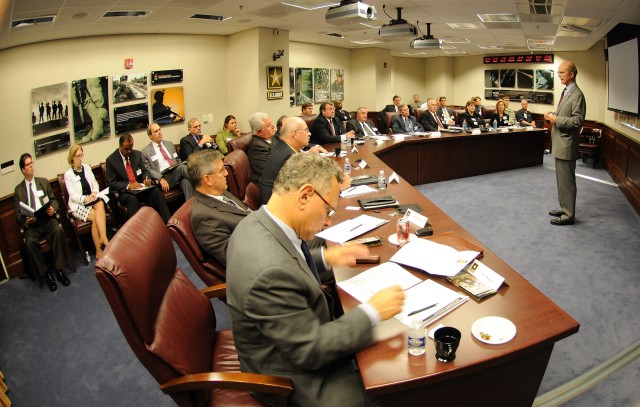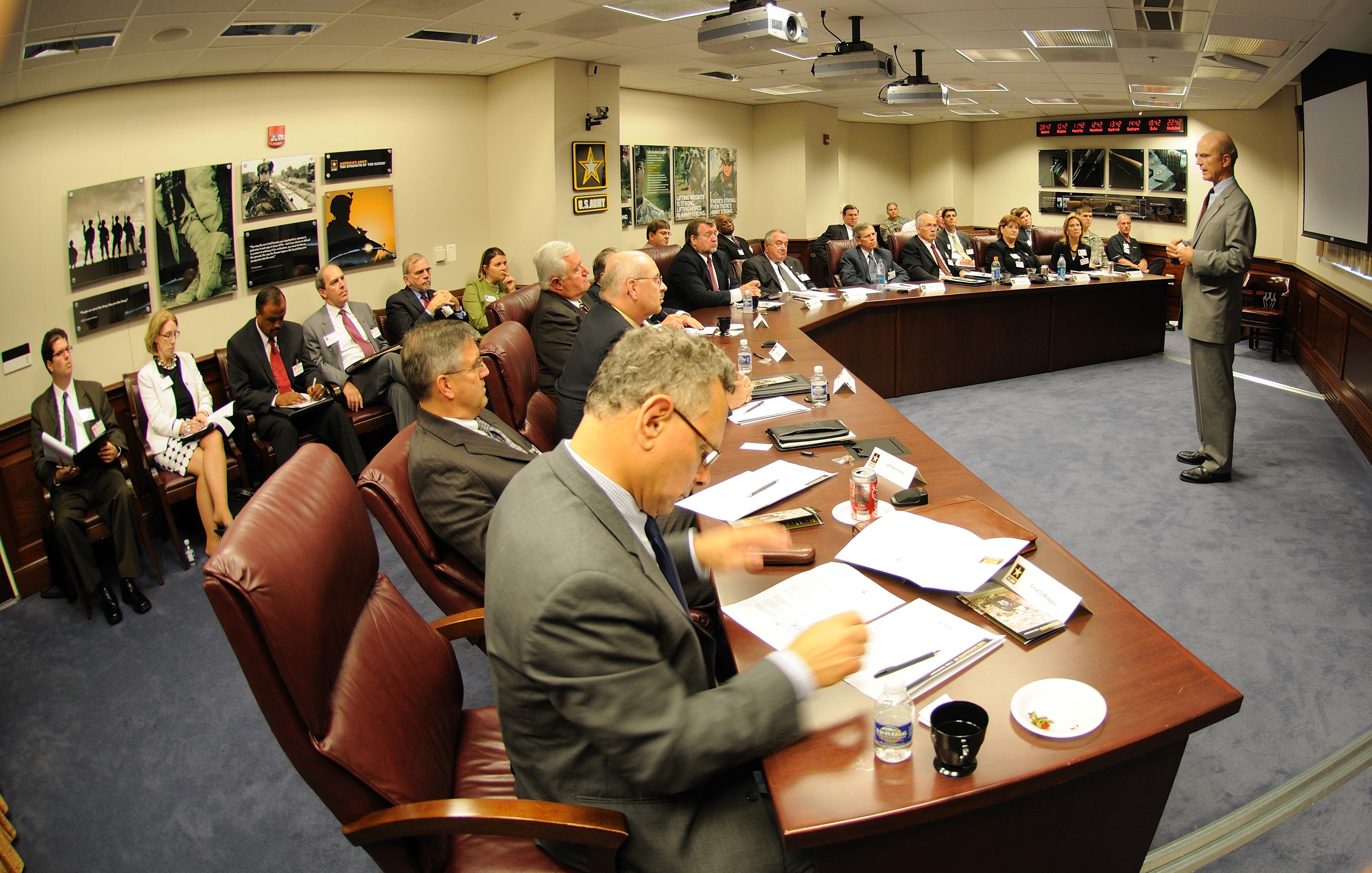WASHINGTON (Army News Service, June 20, 2008) Aca,!" Thirty-one members of the Business Council of New York State paid a fly-in visit to Army leaders at the Pentagon Wednesday where they were briefed on communications strategy, Army reset and the role of the Army in homeland defense matters.
The Business Council of NY State, the largest business organization in the state, included CEOs and CFOs from such companies as Northrop Grumman, Homeland Security Industries, Pitney Bowes and Retlif Testing Laboratories, among others.
Army Chief of Public Affairs Maj. Gen. Anthony Cucolo addressed communication strategies and the fight for the information domain, telling the audience that al-Qaeda has reinvented itself in an attempt to sway the public. He said al Qaeda has realized more than half the battle is taking place in the realm of print, television, radio and Internet media, with more than 6,500 active extremist Web sites.
Aca,!A"If that outfit says more than half the battle is taking place in the battlefield of media, what should our attitude be toward the fight for the information domain'Aca,!A" he said. Aca,!A"I offer to you that it should be aggressive, it should be offensiveAca,!A| fast, public communication is the way to goAca,!A| because the people weAca,!a,,cre fighting on the information domain have no rules.Aca,!A?
Cucolo said Army culture is changing and so is the way in which the Army communicates. Examples of how the Army is communicating is through a requirement by the secretary of the Army and the Army chief of staff that all flag officers, senior executive service flag- officer equivalents and command sergeants major hold press conferences three times quarterly.
Aca,!A"Every Soldier and every Family member is taking pictures, uploading images, sending them to extended family, sending them to friends, because every Soldier and Family member is a communicator,Aca,!A? he said. Aca,!A"Never before has it been so important for us to talk to our internal audience, so weAca,!a,,cre looking for opportunities to come out and talk.Aca,!A?
Addressing the spate of stories accusing the Aca,!A"U.S. of emptying prisons because the Army was desperate for personnel,Aca,!A? the general said that simply wasnAca,!a,,ct true. He said people were making a causal link between juvenile criminal and adult criminal records and that recruit waivers would continue to be granted on a case-by-case basis.
Aca,!A"We have an incredibly high-quality force and we do allow waivers and weAca,!a,,cre not coming off it unless our Congressional leadership tells us to, because the United States Army believes strongly that it is the rung on the ladder of success for some folks, itAca,!a,,cs the place for a second chance,Aca,!A? he said.
Secretary of the Army Pete Geren spoke briefly, telling the audience that one of the most extraordinary things about the Army is the retention rates.
Aca,!A"Soldiers who are going back are staying in, weAca,!a,,cre moving our retention rates up every year, weAca,!a,,cre exceeding our goals every year,Aca,!A? he said. Aca,!A"I think the explanation for that is they believe in what they are doing, that theyAca,!a,,cre making a difference.
Only about three out of 10 youth today meet the basic requirements to join the Army, because of educational, moral or physical shortcomings, according to the secretary. He also said the percentage of waivers was Aca,!A"a tiny, tiny percentageAca,!A? but that those who come in go through a 10-step review process and that many of them who come in through the waiver process are outperforming the Soldiers who enter without the need for waivers.
Aca,!A"WeAca,!a,,cve studied 17,000 of them who came in through a waiver program with some kind of missteps in their pasts -- some minor, some significant -- but after looking at the whole man or whole woman, weAca,!a,,cve given them a second chance and theyAca,!a,,cve performed superbly,Aca,!A? he said.
Maj. Gen. Vincent Boles, assistant deputy chief of staff, G-4, spoke on Army logistics and reset stressing. He said this was the first time in the ArmyAca,!a,,cs 233-year history that the service has simultaneously been fighting a conflict and transforming.
Aca,!A"I check our equipment every morning and I look at all the ground and air systems in the Army and theyAca,!a,,cre over 90-percent ready and have been for the last six years, but weAca,!a,,cre riding our equipment very hard,Aca,!A? he said.
He said the heavy equipment transport vehicle which was designed to carry 72-ton tanks from one location to another was designed in the 1980s to drive only 3,000 miles a year in Germany during the Cold War. On average the Army has more than 3,000 trucks a day on the road in Iraq.
Aca,!A"WeAca,!a,,cre now in Iraq and weAca,!a,,cre driving them 3,000 miles a month and they are staying over 95-percent ready,Aca,!A? he said. Aca,!A"Our depots are operating at twice the capacity of our pre-war levels. We are recapping about 44 Humvees a day, or put another way, a Humvee is rolling off our assembly lines every 11 minutes.Aca,!A?
He also said by 2012 about 90 percent of the Army will be stationed in the continental U.S., Alaska and Hawaii. The 300,000 Soldiers presently in Europe will narrow down to about 30,000 Soldiers and growth between now and 2012 is expected to be about 7,000 Soldiers per year.
Paul McHale, assistant secretary for Defense for homeland defense and AmericaAca,!a,,cs security affairs, told the business group that the threat we face most immediately in an ongoing global conflict involves terrorists or individuals who would acquire weapons of mass destruction and intend to make the United States the primary global battle space.
Aca,!A"An attack here in the United States is not to eliminate our war-fighting capacity, but rather to diminish our war-fighting will,Aca,!A? he said. Aca,!A"If enough casualties, enough damage can be done within the United States, our adversaries believe that while we would have the ability to continue to fight, we would choose not to do so.Aca,!A?
Within the United States homeland, security is a primary mission assigned to the various law enforcement agencies. Domestic security is predominantly a law-enforcement mission, not a military mission, he said, but there are war-fighting capacities under Article 2 of the Constitution that can be brought into play if itAca,!a,,cs determined that a threat cannot be defeated or contained by law-enforcement agencies.
Aca,!A"If we give terrorists a chance, they will strike us here again and if they have the opportunity they will do so with weapons of mass destruction; therefore we in the 21st century have to recognize that is a dominant threat environment,Aca,!A? he said. Aca,!A"We now have dozens of fighter aircraft on near-immediate alert ready to deploy within our own airspace.Aca,!A?


Social Sharing